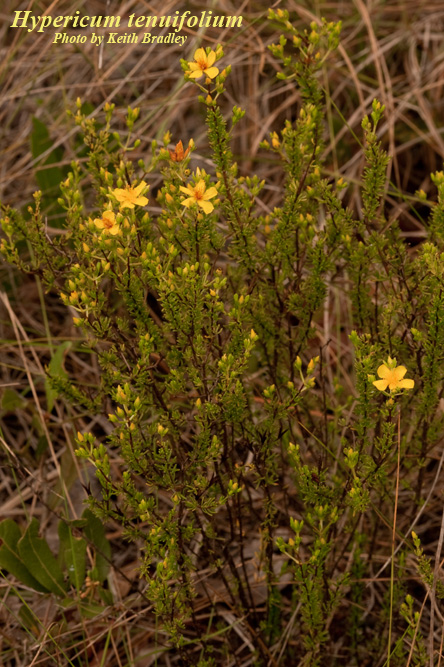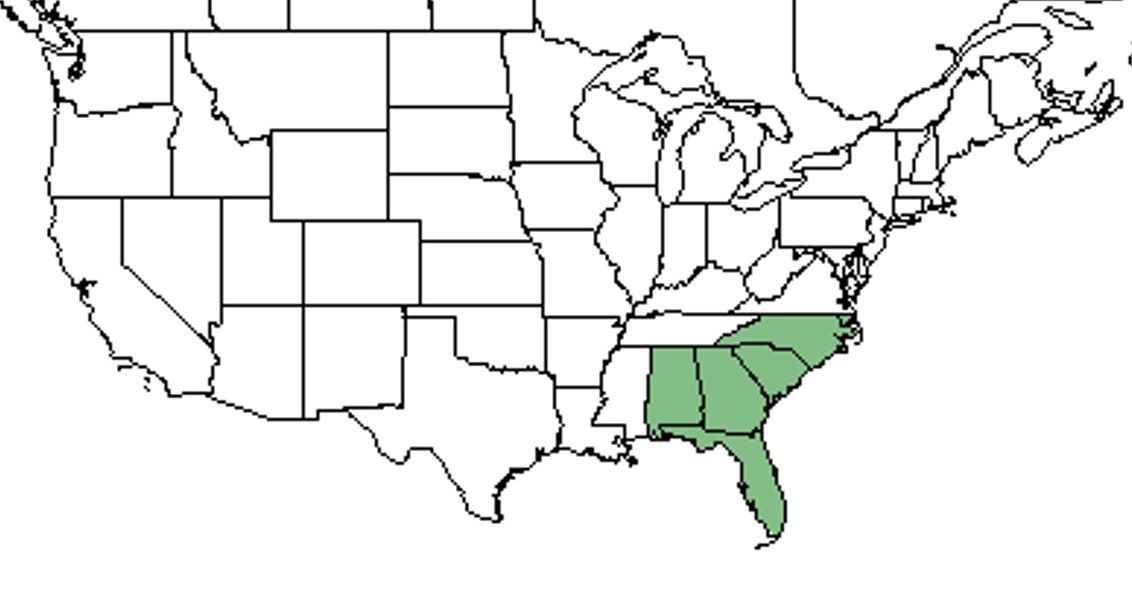Hypericum tenuifolium
| Hypericum tenuifolium | |
|---|---|

| |
| Photo by Keith Bradley, Atlas of Florida Vascular Plants | |
| Scientific classification | |
| Kingdom: | Plantae |
| Division: | Magnoliophyta - Flowering plants |
| Class: | Magnoliopsida - Dicotyledons |
| Order: | Theales |
| Family: | Clusiaceae ⁄ Guttiferae |
| Genus: | Hypericum |
| Species: | H. tenuifolium |
| Binomial name | |
| Hypericum tenuifolium Pursh | |

| |
| Natural range of Hypericum tenuifolium from USDA NRCS Plants Database. | |
Common name: Atlantic St. John's-wort; Sandhill St. John's-wort[1]
Contents
Taxonomic notes
Synonyms: Hypericum reductum (Svenson) W.P. Adams; H. aspalathoides Willdenow.[1]
Varieties: none.[1]
Description
H. tenuifolium is a short-lived perennial herb that can reach heights of 12 to 18 inches. Stems are reddish-brown and are covered with short needle-like shiny, deep-green leaves.[2] The flowers have 5 yellow petals, 5 persistent sepals, a superior ovary, and are bisexual and radially symmetrical.[3] A distinctive characteristic of this species is a long seed capsule, ranging from 6 to 9 mm long.[4]
“Usually glabrous herbs or shrubs. Leaves usually punctate, simple, opposite, entire, usually sessile or subsessile, exstipulate. Inflorescence basically cymose; flowers perfect, regular, bracteates, subsessile or short-pedicellate, sepals 2, 4, or 5, persistent; petals 4 or 5, usually marcescent, yellow or pink; stamens 5-numerous, separate or connate basally forming 3-5 clusters or fascicles, filaments usually persistent; carpels 2-5, stigmas and styles separate or fused, ovary superior, 1-locular or partly or wholly 2-5 locular, placentation axile or parietal. Capsules basically ovoid, longitudinally dehiscent, styles usually persistent; seeds numerous, lustrous, areolate, cylindric, or oblong. In general, our species form a polymorphic complex with many intergrading taxa.”[5]
"Decumbent, matted shrub, 1-5 dm tall, stems usually angled. Leaves linear-subulate, the largest 5-13 mm long, 0.5-1 mm wide, acute, slightly revolute, base notched, sessile. Cymules or dichasia terminal and axillary, or flower solitary, axillary. Sepals 5, similar to leaves, usually less than4.5 mm long; petals 5, 4-10 mm long; styles 3, united or usually separate in fruit, 0.8-3 mm long, ovary 3-locular. Capsules subcylindric, 6-9 mm long, 1.5-2 mm broad; seeds blackish, ca. 0.5 mm long."[5]
Distribution
This plant occurs from southeastern North Carolina to southern peninsular Florida, as well as throughout the Florida Panhandle and southeastern Alabama.[1]
Ecology
Habitat
This species is found in dry, sandy, open sites with good drainage such as sandy woods, dunes and dune hollows, lowland, and coastal areas.[6] It is drought tolerant, however, it does not favor well in soils that remain wet for extended periods.[2] Associated species include Polygonella polygama, Pinus palustris, and Paronychia chartacea.[7]
Phenology
Flowering occurs during late spring and early summer with more than a dozen flowers open at any time.[2] Flowers are yellow and aromatic with the fruit capsule ranging from 6 to 9 mm in length.[4]
Pollination and use by animals
The following Hymenoptera families and species were observed visiting flowers of Hypericum tenuifolium at the Archbold Biological Station:[8]
Bees from the family Apidae: Apis mellifera, Bombus griseocollis, B. impatiens
Plasterer bees from the family Colletidae: Colletes distinctus, C. productus, C. sp. A, Hylaeus confluens
Sweat bees from the family Halictidae: Augochlorella aurata, A. gratiosa, Augochloropsis anonyma, A. metallica, A. sumptuosa, Lasioglossum miniatulus, L. nymphalis, L. placidensis, L. tamiamensis
Leafcutting bees from the family Megachilidae: Anthidiellum perplexum, Dianthidium floridiense, Megachile albitarsis, M. brevis pseudobrevis, M. rugifrons
Conservation, cultivation, and restoration
Cultural use
Photo Gallery
References and notes
- ↑ 1.0 1.1 1.2 1.3 Weakley, A.S. 2015. Flora of the southern and mid-atlantic states. Working Draft of 21 May 2015. University of North Carolina at Chapel Hill, Chapel Hill, North Carolina.
- ↑ 2.0 2.1 2.2 [[1]]UGA Extension Accessed: January 6, 2016
- ↑ [[2]] Name that Plant. Accessed: January 6, 2016
- ↑ 4.0 4.1 [[3]] Accessed: January 6, 2016
- ↑ 5.0 5.1 Radford, Albert E., Harry E. Ahles, and C. Ritchie Bell. Manual of the Vascular Flora of the Carolinas. 1964, 1968. The University of North Carolina Press. 709-712. Print.
- ↑ [[4]] Hypericum online. Accessed: January 6, 2016
- ↑ Florida State University Robert K. Godfrey Herbarium database. URL: http://herbarium.bio.fsu.edu. Last accessed: October 2015. Collectors: Loran C. Anderson, Wilson Baker, Ann Johnson. States and Counties: Florida: Bay. Compiled by Tall Timbers Research Station and Land Conservancy.
- ↑ Deyrup, M.A. and N.D. 2015. Database of observations of Hymenoptera visitations to flowers of plants on Archbold Biological Station, Florida, USA.